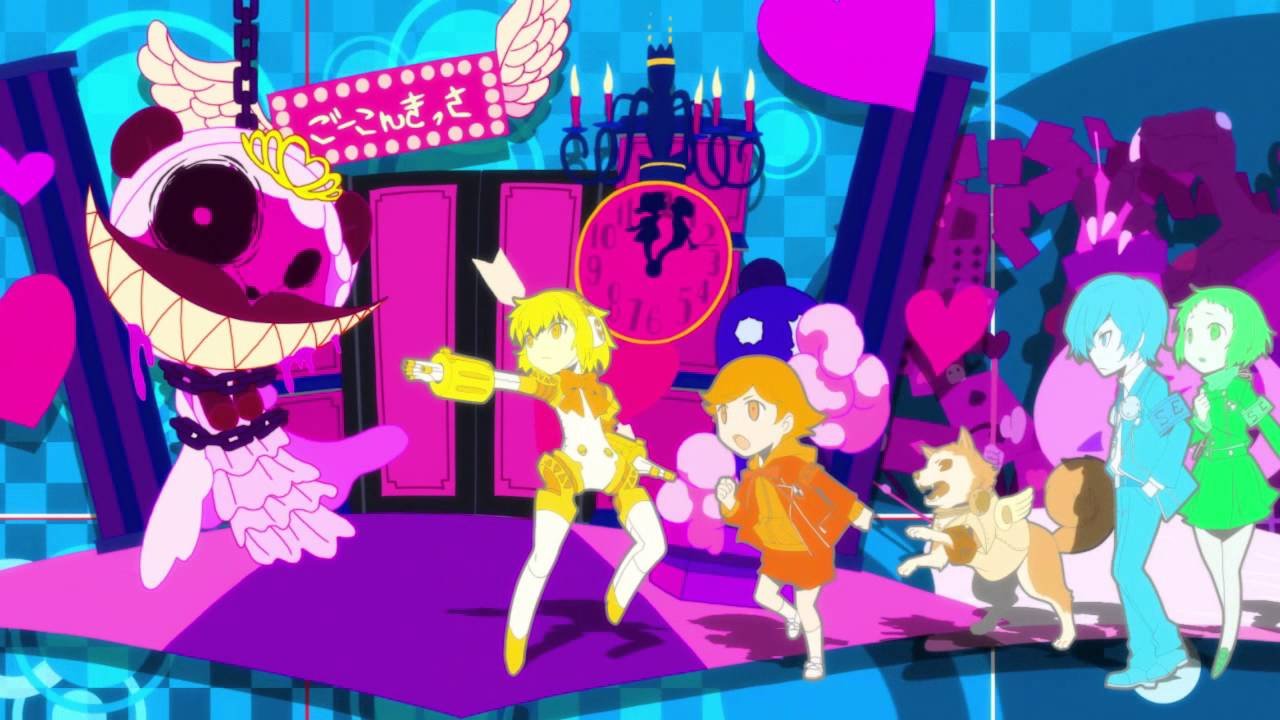The summer of 2005 marked itself as the first time I ever held a Shin Megami Tensei game in my hands. I knew nothing about this series, but the cover of the third title from the main series made me really curious, so I took Lucifer’s Call home with me. Unsuspectingly, because I couldn’t have foreseen that this game, and the rest of the series, with demons, mythical figures and dark worlds would turn my life upside down in a way that Final Fantasy could ever do.
One of these spin-offs are the ‘Persona’ games, that calls out to the youth to stop the destruction of the earth as they know it. Here in Europa most of got to know this series when Persona 3 hit the shelves. Sadly, this great title didn’t get the attention it deserved with the big public. But it does seem like mouth-to-mouth advertisement did its job for P3, since Persona 4 was an immediate must-play for JRPG lovers.
With the success of Persona 3 and especially Persona 4 the special editions, movies, musicals and spin-off titles were not far away. Persona Q: Shadows of the Labyrinth for 3DS, containing all the heroes from P3 and P4, is a good example of a spin-off.
[youtube https://www.youtube.com/watch?v=Es_wCYzxX38]
Orpheus of Izanagi
Persona Q gives you’re the chance to follow the story through the eyes of the group from Persona 3 or Persona 4. Your choice gives you a different prologue, makes your chosen hero the silent-protagonist of service while the others get a fixed character and change some plot points a bit, but it doesn’t change the course of the story. The five different difficulties ranging from ‘Safety’ (easy fighting sequences so you can fully focus on the story) to ‘Risky’ (the ‘prepare to die’ mode where dying doesn’t mean a Game Over, but a Game End) give you sufficient ways to make the game as comfortable or challenging as you want it to be.
The story
At the beginning of Persona Q, the heroes from P4 are busy with the cultural festival for their high school, when they suddenly hear a strange bell. It doesn’t take long before Margaret, the contact point for the Velvet Room, let them know that she heard the same bell. This can’t be a coincidence! When the entire group is being welcomed in the Velvet Room for the first time, the room is transformed in an unstable mess of platforms and stairs. Two mysterious, chained doors seem to keep watch. Even the school isn’t what it was anymore, where once the hallways filled itself with lively students, now there’s nothing left but reflections of a non-existing reality. Strange new attractions full of Shadows appear on the weirdest places, a clock tower, who has been gone for years, is suddenly proudly standing at the school again. As if that wasn’t enough, two young teenagers, Zen and Rei, are stuck in this reality for a long time. For Margaret it’s clear: something disrupted the Space-Time Continuum and if the Investigation Team and their two new friends want to escape from this strange world, they are going to have to beat the Shadows and find out who is behind all this.
For the heroes of Persona 3 there is just a bit more sci-fi. When a typhoon hits the area of Iwatodai in 2009 and the cultural festival gets cancelled, the protagonist from Persona 3 goes, sick with SEES, to Tartarus. He still feels bad after being in bed for a few days, but a strange feeling drives him towards the with shadows loaded tower. It doesn’t take long before he, all his friends and Elizabeth and Theodore hear the same weird bell in the Velvet Room and are transported to the same non-reality that the Investigation Team is stuck in. It becomes clear that if the SEES ever want to beat Nyx in their own reality, they will have to escape from this strange world first. Luckily both teams meet each other soon at the first boss-battle, and with the motto ‘less work with more hands’ they team up to reveal the secret of Yasogami High.
Kyuu Gameplay
When I saw the title for the first time, I wondered where the Q stood for. ‘Is it an alternative for the popular X?’ I thought to myself, but the truth is very different. Persona Q: Shadows of the Labyrinth gets the Q from a very different Atlus series: Etrian Odyssey. Etrian Odyssey name is ‘Sekaiju no Meikyuu’ in Japanese and since Persona Q has many gameplay features from this series, it’s not strange at all that the Q (or kyuu) has found its way to the title.
In Persona Q the gameplay focuses, like de Etrian Odyssey games, on first-person dungeon crawling in labyrinths full of enemies. Each level of the various labyrinths become bigger and more confusions until they become a gigantic boss-fight. You pass the treacherous hallways with a team of 5 while you unlock the various paths, doors, chests, Power Spots and shortcuts with your stylus. The last thing is a really fun thing to do when you find your way through the labyrinth. The 3D-effects in every room makes perfect use of the abilities of the 3DS in my opinion. For the first time while playing a SMT 3DS title, I got the feeling that both the use of the 3D as well as the use of the touchpad were really good.
During the fights you feel the effort the various teams from Persona Q put into the game to mix the elements of both Etrian Odyssey and Shin Megami Tensei. The ‘One More’ principle that you have in P3 and P4, is no more, but is replaced in Persona Q with a ‘Boost status’. A persona in ‘Boost’ can conduct the next attack without using HP of SP (which is really handy), but loses the status when you are being attacked. ‘Boost’ isn’t online handy for energy-saving; the more Persona’s are in ‘Boost’, the bigger the chance for you to have an All-Out-Attack and to receive a new Persona!
A different aspect from the Etrian Odyssey games, are the different FOEs that cross your path. FOEs, aka ‘Field On Enemies’ in Etrian Odyssey or ‘Physis Oikein Eidolon’ in Persona Q, are strong enemies who are best to be avoided. This part really reminds me of the Reaper who stalks you through Tartarus in Persona Q, your dead if he catches you when your low level. Each FOE have a different behavioural pattern so most of them are easily avoided.
Sub-Persona
You can’t talk about a Persona game and don’t discuss de Persona’s. In the Persona series each persona can, as part of their true self, call the mask or the ‘Persona’ to fight for him/her. Each Persona is impersonated by a mythical figure and is part of the users’ personality. In both Persona 3 as 4 everyone can only call 1 Persona, with exception of the ‘wild-cards’, the protagonists, who are the only one in their team to switch Persona.
In Persona Q it can get pretty messy if two different characters want the same Persona. If two wild-cards come together in the same place, it messes with the powers of it, so everyone gets the powers in a mild form. This makes the fights a lot more interesting, since you can combine Persona’s with attacking and healing skills, making you a lot stronger.
Soundtrack and Voice-acting
The soundtrack of Persona Q is finger-licking good. They mix the soundtrack from P3 and P4 and it fills the game with nostalgia, while it’s still a new sound. Especially the soundtrack during the boss-battles gets you in the right mood to kick some ass. A downside of the soundtrack, is that the duration can get too long, if you’re lost in a dungeon for example, and it drives your completely crazy. The first level is like this, but luckily the soundtrack changes once you get deeper into the labyrinth.
Persona Q is completely voiced-oved, minus the parts that aren’t immediately important to the main story. The original English voices are back, and again with excellent quality.
Hiccups?
Persona Q is a really fun game, that’s a fact, but there are a few points that are a bit less. In P3 and p4 social interactions are a big part of the game. In Persona Q these experiences are sadly enough replaced by the so called ‘Strolls’, which are moments you experience with the rest of your team. They are fun little pauses of the dungeons, but they have little added value. You get to know your team better, maybe do a job for them, but that’s about it. I also dislike the claustrophobic in-game menu. Almost half the screen is menu-options, while a small 3D scene shows the situation in school. I wonder if a different usage of the double screen would have been better.
Finally, there is the story, that doesn’t give a really good reason for the many characters to work together. During the game this is made very obvious by the ability to pimp your favourite characters so you don’t need anyone else, this results in you playing the whole game with the same team. Unlike other Persona RPGs, there is no difference between the ‘good ending’ and the ‘bad ending’ which makes the game straighter forward than it has to be. And to be honest, I really missed the ‘bad ending’. Nothing is more frustrating than the game being ended to early due to some stupid choice you made, and this makes the Persona storylines that bit more exciting.
Conclusion
Persona Q: Shadow of the Labyrinth is a fun game for those who have Persona 3 and Persona 4 on their list of favourite games, or for those who want to get to know the series before Persona 5 is released. The story may not be big or important, but the interaction between characters, the killer soundtrack, the Etrian Odyssey-like cartography, the nods to plot points who still have to happen and the references to other Atlus titles (like Catherine), make Persona Q a must-have for every Persona-fan.
Persona Q: Shadow of the Labyrinth is in stores since November 28th 2014 for Nintendo 3DS.
Info:
Title: Persona Q: Shadow of the Labyrinth
Genre: JRPG, dungeon crawler
Developer: Atlus
Publisher: NIS America (Europe)
Rating: 87/100




















